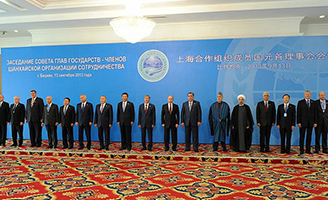Kazakhstan to Reform Its Cultural Sector
By Rafis Abazov and Andrey Khazbulatov (05/13/2015 issue of the CACI Analyst)
In his presidential election campaign, Kazakhstan’s President Nursultan Nazarbayev pledged special attention to cultural policy through implementation of the Concept of Cultural Policy, envisioned to streamline the country’s policies on culture, cultural education and arts to strengthen what he calls “the genetic [cultural] code of the nation.” In introducing this Concept, Kazakhstan’s government emphasizes cultural policies despite the current financial crisis and significant budget cuts due to falling oil prices in the international market. But will reforming its cultural sphere deliver expected outcomes and results?

Kazakhstan and Neighbors Seek Strategies to Counter Emerging Threats
By Jakob Zenn (04/29/2015 issue of the CACI Analyst)
Central Asian governments are speaking openly about threats they face from the multiple security and economic crises surrounding their region. In November 2014, Kazakhstan’s President Nursultan Nazarbayev discussed in his annual address the region’s “worsening geopolitical context” with new crises in Ukraine, as well as in Syria and Iraq, the still unresolved “old” conflict in Afghanistan, and the negative impact on Central Asian economies resulting from Western sanctions on Russia. To counter these negative security and economic trends, Central Asian governments have adopted various approaches ranging from more progressive ones in Kazakhstan to stagnant or indecisive ones in other countries.

Azerbaijan and Kazakhstan Face Tough Economic Decisions amid Decreasing Oil Price
By Nurzhan Zhambekov (04/01/2015 issue of the CACI Analyst)
Azerbaijan and Kazakhstan face a tough year as oil prices plummet. A dramatic shift has occurred in the international oil market in recent months as oil supply has gone up, particularly with the U.S. oil production increase, and demand has weakened with the economic slowdown in China and the EU. Saudi Arabia, the world’s second largest oil producer, did not reduce its oil production despite the oil price decline, indicating that it would like to maintain its international oil market share. The precipitous decline in oil prices has resulted in a sharp fall in export revenues for Azerbaijan and Kazakhstan, the third and second largest oil producers respectively in the former-Soviet Union after Russia. This dramatic price drop has put the two countries’ currencies under severe pressure.

CACI Analyst, March 3, 2015
CACI Analyst, March 4, 2015 (.pdf)
Contents
Analytical Articles
KAZAKHSTAN AND THE EEU, by Dmitry Shlapentokh
U.S. NEW SILK ROAD INITIATIVE NEEDS URGENT RENEWAL, by Richard Weitz
IS “TURKISH STREAM” A SERIOUS THREAT TO THE TRANS-CASPIAN PIPELINE?, by Juraj Beskid, Tomáš Baranec
CASA-1,000 – HIGH VOLTAGE IN CENTRAL ASIA, by Franz J. Marty
Field Reports
KYRGYZSTAN’S RESIGNED PROSECUTOR-GENERAL GIVES WORRYING PRESS CONFERENCE, by Arslan Sabyrbekov
MOSCOW PLEDGES TO COUNTERACT GEORGIA’S INTEGRATION WITH NATO, by Eka Janashia
ARMENIA TOUGHENS ITS STANCE AGAINST TURKEY, by Erik Davtyan
FOREIGN MINISTERS OF TURKEY, AZERBAIJAN AND TURKMENISTAN DISCUSS ENERGY AND TRANSPORTATION IN ASHGABAT, by Tavus Rejepova
Kazakhstan and the EEU
By Dmitry Shlapentokh (03/04/2015 issue of the CACI Analyst)
January 2015 marked the beginning of a new relationship between Russia, Kazakhstan and Belarus bound together by the Eurasian Economic Union (EEU). Yet the emerging friction between Astana and Moscow indicates the pitfalls of the EEU as a project, at least as conceptualized by the Kremlin. In August 2014, Kazakhstan’s and Russia’s leaderships engaged in an exchange of cold remarks. Through late fall (October-November 2014), Russian politicians and journalists discussed the suffering of Russians in Northern Kazakhstan and Russia’s responsibility for their situation. As the EEU was finally inaugurated, economic and geopolitical tensions between Astana and Moscow continued, indicating the EEU’s economic and geopolitical instability.







